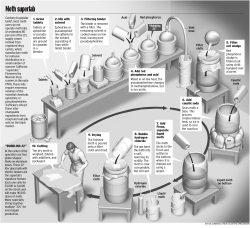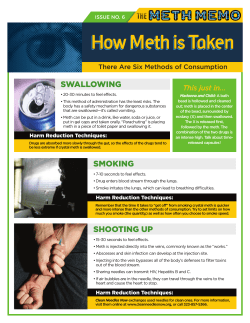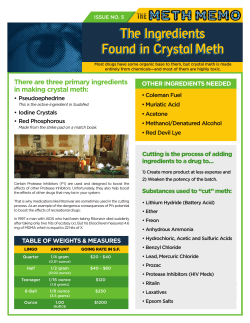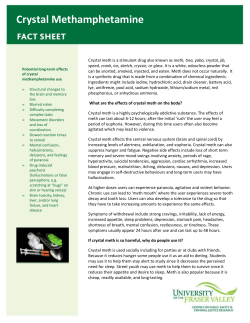
On-Scene Safety Information for First Responders Encountering a Meth Lab W
C T D e p a r t m e n t o f P u b li c H e a lt h May 2006 On-Scene Safety Information for First Responders Encountering a Meth Lab W H AT I S M E T H ? Methamphetamine (Meth) is a highly addictive drug that can be synthesized in small-scale makeshift labs. Meth is toxic and can cause permanent damage to the brain and other vital organs. Meth use can cause strokes, seizures, and even death. Meth is “cooked” in illegal labs and can be found in many forms, including pills, powder, and chunks. Meth can be smoked, snorted, injected, or swallowed. Common street names for meth include crack, crystal, speed, or ice. WHERE WOULD I FIND A METH LAB? Meth labs can be found nearly anywhere, but are most often found in rental homes, storage sheds, vacant buildings, apartments, rest areas, RVs, and motel rooms. W H AT C O M M O N S U P P L I E S A R E F O U N D / U S E D IN A METH LAB? Chemicals Common Cold or Allergy Pills Containing Pseudoephedrine or Ephedrine Alcohol (Isopropyl or Rubbing) Acetone Drain Cleaner (Sulfuric Acid) Engine Starter (Ether) Iodine Ηeet /Gasoline Additives (Methanol/Alcohol) Lithium Batteries Matches (Red Phosphorus) Muriatic Acid Anhydrous Ammonia Red Devil Lye Salt (Table or Rock) Sodium Metal Trichloroethane (Gun Cleaning Solvent) Aluminum Foil Blender Bottles Cheesecloths Coffee Filters Funnels Gas Can Hot Plate Jugs Paper Towels Propane Tank Pyrex Dishes Rubber Gloves/ Tubing Strainer Tape/Clamps Equipment O n - S c e n e S a f e t y I n f o r m a t i o n f o r F i r s t R e s p o n d e r s E nc o u n t e r i n g a M e t h L a b Page 2 WARNING SIGNS OF A METH LAB: THINGS TO LOOK FOR WHEN IDENTIFYING A METH LAB: • • • • • • • • • • Unusual, strong odors (like cat urine, ether, ammonia, acetone, or other chemicals). Residences with windows blacked out. Renters who pay their landlords in cash. Excessive traffic in and out of the residence at unusual times. Excessive trash including large amounts of items such as antifreeze containers, lantern fuel cans, stained coffee filters, drain cleaner, and duct tape. Unusually large amounts of clean glass containers being brought into the house. Secretive/protective area surrounding the residence (video cameras, alarm system, guard dogs, reinforced doors, electric fencing). Persons exiting the residence to smoke. Little or no mail, furniture, and no newspaper delivery. CHECKLIST FOR FIRST RESPONSE: A law enforcement officer who discovers an operating meth lab should immediately do the following: √ √ √ √ √ √ √ √ Assure that all persons in the immediate area (including law enforcement personnel) are removed to a safe location. Depending upon the size of the lab and the amount of toxic chemicals being emitted, this may involve evacuation of the neighborhood. Call for fire/Hazmat to respond to the location. Call the US Drug Enforcement Administration (DEA) at 860-240-3233 (Hartford) , 203-497-5200 (New Haven), or 203-579-5591 (Bridgeport) immediately. Call the CT Department of Children and Families (CT DCF) hotline at 1-800-842-2288 if children are present. Inform the local health department, the Connecticut Department of Public Health (CT DPH) (860-5097742), and the the Connecticut Department of Environmental Protection (CT DEP) (860-424-3338) or toll free at 1-866-DEP SPILL (24 hrs/7 days/wk emergency line). Establish an outer perimeter area and keep all unnecessary persons from entering. Ventilating the lab should only be done by certified personnel hired by the DEA or CT DEP to cleanup the lab. If you feel any signs of dizziness, difficulty breathing, confusion, or burning of the skin, lungs, or other mucous membranes, do not stay in the area. Leave immediately and seek medical advice/ treatment. Page 3 D O N OT: × × × × × × × × × Turn any electrical devices/lights on or off. This simple act of turning on an electrical switch—even a flashlight—may cause an explosion. Attempt to stop the chemical reaction if “cooking” is going on. Shut off the water supply to the house or to the chemical reaction. Use your firearm if at all possible. Firing inside a lab could cause an explosion. Smell the contents of any container. Smoke or allow anyone else to smoke. Open or move any containers. Touch any unknown substances with your bare skin. If involved with photographic devices, do not use standard flashbulbs. Instead, use special photographic strobe equipment that has no possibility of generating a spark. Note: These precautions are for the meth lab property and not a neighboring property. GUIDELINES FOR STAFF FROM AGENCIES OTHER THAN LAW ENFORCEMENT : ♦ ♦ ♦ ♦ ♦ Do not enter contaminated area prior to ventilation, shutdown of equipment, and removal of chemicals and equipment. Minimize exposure by limiting time on-site and wearing protective clothing as needed. Evaluate exposure and take measures to contain or eliminate it, e.g., by washing exposed skin and removing contaminated shoes or clothing. Take steps to avoid transporting contamination on yourself or someone in your care. Seek medical care if needed. W H AT A R E T H E E N V I R O N M E N TA L CONSEQUENCES OF METH LABS? Each pound of meth produced leaves behind five or six pounds of toxic waste. In addition, residue from the cooking process can contaminate all surfaces of the property where the cooking took place including furniture, walls, carpeting, floors, clothing, and appliances. Meth cooks often pour leftover chemicals and by-product sludge down drains into nearby plumbing, down storm drains, or directly onto the ground, contaminating drinking water wells, septic systems, and soil. Chlorinated solvents and other toxic by-products used to make meth pose long-term hazards because they can persist in soil and groundwater for years. Cleanup costs are expensive because solvent contaminated soil usually must be incinerated. W H AT S H O U L D B E D O N E W I T H L A B SCENE CHEMICALS AFTER A RAID? The DEA or CT DEP will hire a contractor to remove the bulk material. Only people with proper certification and equipment should transport materials found in a meth lab. Chemicals, containers, and materials should not be transported in police cruisers and stored in evidence lockers as they will contaminate all areas with which they come into contact. Often chemicals are unstable and may be explosive or poisonous. W H AT A B O U T C L E A N I N G U P T H E PROPERTY AFTER THE CHEMICALS H AV E B E E N R E M OV E D ? The residual contamination on indoor and outdoor surfaces (carpeting, walls, floors, etc.,) should be carefully inspected and cleaned according to CT DPH’s Guidelines for the Cleanup of Connecticut Methamphetamine Labs. Residue cleanup is the responsibility of the property owner. CT DPH strongly recommends that meth labs be cleaned by contractors who are trained and equipped to conduct hazardous chemical remediation and cleanup of meth labs according to these guidelines. For a copy of these guidelines or a list of contractors who are trained to cleanup former meth labs, please contact the Environmental and Occupational Health Assessment Program at (860) 509-7742. W H AT S H O U L D I D O I F C H I L D R E N A R E FOUND IN A METH LAB? Children found in these conditions are often malnourished, improperly clothed, and neglected. Many of them test positive for meth in their bodies. This is due to the access they have to the drug or exposure to second-hand smoke resulting from a cook or a user smoking in close proximity to the child. Heath effects from exposure to meth in children are liver damage, learning disabilities, and death as a result of fires and explosions from the labs. Officers should call the CT DCF hotline at 1-800–842-2288 and explain the conditions in which the children were found and the dangers of the living environment. Children should have a complete physical performed by a doctor to determine the level of exposure and any health effects. W H O C A N I C A L L F O R M O R E I N F O R M AT I O N ? CT Department of Public Health (860) 509-7742 CT Methamphetamine Task Force Bob Brex (860) 779-9253 This fact sheet is funded in part by funds from the Comprehensive Environmental Response, Compensation, and Liability Act trust fund through a cooperative agreement with the Agency for Toxic Substances and Disease Registry, Public Health Service, U.S. Department of Health and Human Services.)
© Copyright 2025





















